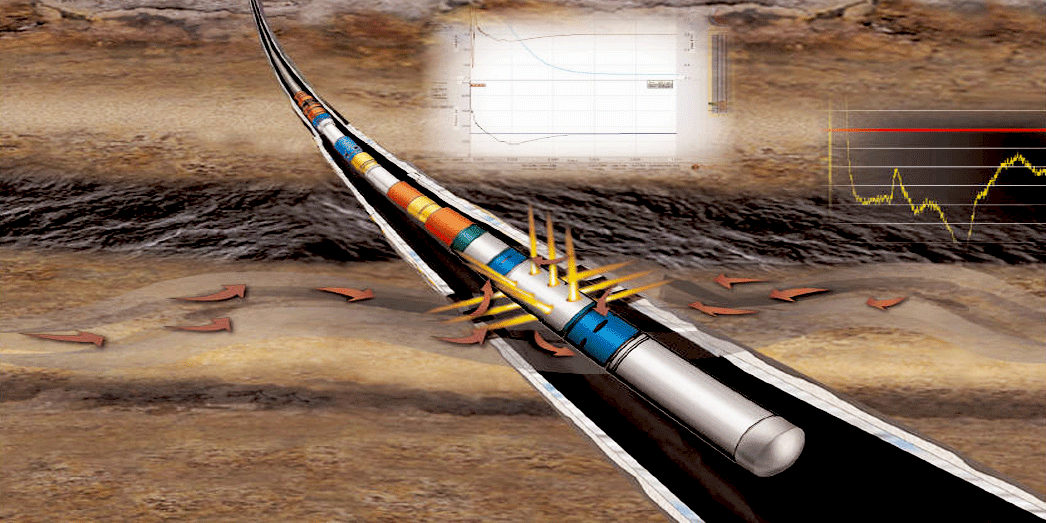Shale-gas resources were explored in Saudi Arabia by adopting a “technology-driven” approach against the US-based approach that might be termed the “factory” or “statistical” approach. The technology-driven approach and the customized work flow applied in this project have minimized the time required to understand the reservoir and apply the appropriate technologies. To date, this work flow has been used and calibrated with single-well analysis.
Introduction
The technology-driven approach to acquiring data was accomplished by maximizing data collection and developing a customized work flow to rapidly in-corporate lessons learned for the next wells drilled. The overall challenge was to perform the assessment quickly and execute operations efficiently because of the quick drilling program with multiple rigs working.
Typically, a resource rock is evaluated, tested, and produced with individual tools and optimized by a statistical approach because of the number of wells drilled and completed in the area. In the study case, the well is an exploration well 1500 km away from the oilfield infrastructure with no offset-well information to support evaluation of the well. The approach was to build a single functioning model, combining a basin resource work flow with a hydraulic fracture- design work flow. The foundation pieces for this model must contain, at minimum, the following:
Core: Acquiring a core is essential because rock properties are required in geology, petrophysics, geomechanics, drilling, and fracturing. Both resource and bounding layers need to be included in this work.
Petrophysics: Logging programs need to deliver all data for the models and to be recalibrated on the basis of core and performance of the well.
Geology: A depositional model is critical because tectonism influences the trapping potential of the source rock. Recalibration is performed on the basis of the core and petrophysics.
Geomechanics: Both isotropic- and anisotropic-based models need to be constructed for drilling and stimulation requirements. The models need to integrate static core data and dynamic logging data, recalibrated with vertical well stress testing through microfracturing, if possible.
Drilling: Geomechanics is necessary for proper landing and drilling of the horizontal well along with the proper construction of the completion to handle pump rates and pressure.
Stimulation modeling: The model needs to be built on geological information of the area, and petrophysical and geomechanical data. The model should also incorporate mechanical limitations on the basis of completion capabilities such as maximum treating pressures or poor cement-bond logs.
Microseismic: This provides an effective stimulation volume. The process needs to be integrated into the stimulation execution in real-time mode.
Production Data: A simplistic production model should be developed initially to understand production declines associated with stimulated volumes and fracture geometries. Model complexity increases with additional data.
Case Study
The North Arabian shale Well A-1 has a gross interval of 2,000 ft. The shale is made up of two distinct rock lithologies. The top lithology is made up of 70% clay, making it ductile and difficult to fracture and recover hydrocarbons. The second rock type is brittle, with 60% quartz andillite clays. The well passed all criteria except for being under pressured.
A pilot hole was drilled to acquire data for the construction of the geo mechanical model, and the hole was used for lateral placement and fracture design. Core was obtained above, across, and below the targeted shale to obtain Young’s modulus, Poisson’s ratio, triaxial stress, source rock, and the upper and lower barriers. To complement the triaxial tests further, micro-fracture tests are performed at key identified intervals. The micro fractures were used to calibrate the stess model in the ductile shale, transition zone between the shale, and siltstone below. Furthermore, the micro fractures provided calibration for the wellbore-stability model used to land the lateral section in the shale.
Lateral wellbore placement required the well to be drilled into the minimum-stress direction to ensure that vertical fractures were placed along the lateral well. Regional drilling in North Arabia indicated that the maximum-stress gradient was N10°W, which was verified in the pilot hole by acquiring an image log of the borehole to determine wellbore break-out and natural-fracture identification. Preliminary fracture modeling was performed to determine whether the stimulation would grow up or down. Modeling for Well A-1 indicated downward growth, which supported the drilling of the later-al at the top of the hot shale.
Well A-1 was planned for a 3,000-ftlateral in the hot shale, allowing sufficient length for multistage fracturing. Seismic data indicated the formation had a constant 1.5° dip, and the well was geo-steered successfully, staying at the top of the hot shale; it was completed with a cemented 4½-in. liner. Open hole logs and a cement-bond log were obtained to build a completion-adviser log. Incorporating a cement-bond log is critical to the final placement of clusters, to ensure isolation between clusters. It was also critical as part of a new cementing procedure for the shale, which resulted in 98% of the lateral having good bond.
The completion adviser logs segments of the lateral with respect to the targeted formation, well undulations, trajectory, and formation properties. Hydraulic-fracture stages are then segmented with similar rock stresses, rock quality, and composite quality index. The composite quality index is a combination of reservoir quality porosity and mineralogy makeup for a shale formation and the completion quality, which includes rock properties and the cement-bond log.
To achieve optimal stimulated reservoir volume, 12 stages were identified from the completion adviser for Well A-1.Within these 12 stages, four fracturing techniques using conventional, hybrid, slick water, and channel-fracture design were used to provide a quick assessment of fracturing efficiency and production off take. Trying to assess this many techniques in a single lateral later proved to be too complex to assess the fracture performance, because of too many unconrollable variables in well operations and reservoir quality.
To improve well-operation performance, capillary suction-time testing was performed to determine salt concentration required to prevent clay swelling. Results from the test indicated a clay substitute was sufficient to control clays welling. This quick test resulted in eliminating the need to premix all the fracturing tanks with KCl, thus improving operation performance and surface tankage requirements for fracturing water.
A small breakdown-and-fall off test was performed at the toe of the well, and it compared favorably with the microfracture tests performed in the pilot hole. This later became the standard operation for all stages, to determine whether a new fracture was being initiated or the opera-tors were breaking into existing natural fractures or the preceding fracture stage.
Fracture-slurry volumes were similar in size for all four techniques, and100-mesh and 40/70 high-strength prop-pant (HSP) was used. The convention aland channel-fracturing designs proved to be the preferred fracture designs on the basis of ease of placement, microseismic events, and production contribution. Production from theses stages resulted in 77% of the gas contribution. The slick-water and hybrid fracture designs resulted in poor production contribution and microseismic activity. The poor results, though, were thought to be from a combination of early design learnings and rate restrictions because of maximum-pressure limitations of the completion. The poor results could also be attributed to using the heavier HSP and not being able to displace the proppant down the fracture.
The 12 fractures were completed with-in 13 days, excluding the time it took for an early fishing and proppant cleanout operation. Fracture-slurry volumes were similar in size for all four techniques, and100-mesh and 40/70 HSP was used for the proppant. The HSP was used because of its availability, but it was not the preferred proppant for the well.
All fracture treatments show production contribution, with the majority of the gas coming from the channel and conventional designs. Of note is the production from all stimulated stages, with no zones indicating a lack off low contribution. Microseismic activity interpretation is less clear because the fractures appear to have limited propagation and are all connected near the well-bore. These data also suggest that the fracture geometry has no effect on production because the stages with limited fracture-length growth appear to have similar production gains. Fracture-height growth from the micro seismic also indicated a preferred upward growth.
Conclusions
Final production results were promising. To make the shale play viable in northern Saudi Arabia, additional work is still required to understand the geology and fracturing results as they relate to the final production rates. Additional work is ongoing to determine the source of flow-back water through geochemistry and age dating. Improvements to the fracture model are required to take into account how the rock fabric and natural fractures influence fracture geometry. The fractured stimulated volume also needs to be understood better because the micro-seismic is indicating short planar fractures vs. complex fracturing that contacts additional reservoirs.

 石油圈
石油圈

